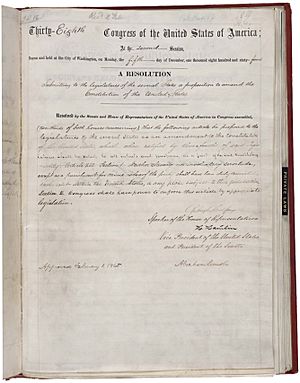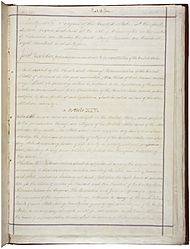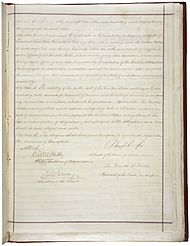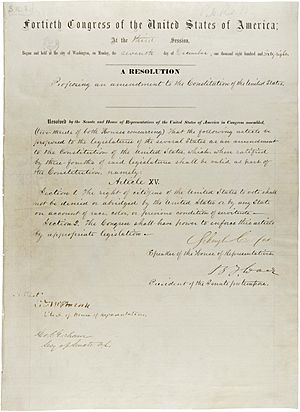Reconstruction Amendments facts for kids
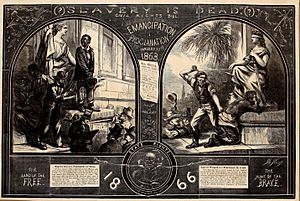
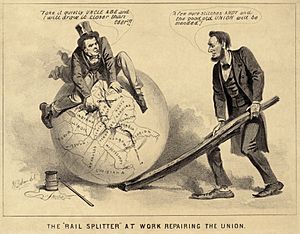
The Reconstruction Amendments are three important changes to the United States Constitution. They are the Thirteenth, Fourteenth, and Fifteenth amendments. These changes were added between 1865 and 1870. They were a big part of the plan to rebuild the American South after the Civil War. This time was known as the Reconstruction period.
The Thirteenth Amendment was approved in 1865. It ended slavery and forced labor, except as punishment for a crime. The Fourteenth Amendment was approved in 1868. It explained who was a citizen and said everyone should be treated equally by the law. The Fifteenth Amendment was approved in 1870. It made it illegal to stop people from voting because of their "race, color, or previous condition of servitude." This meant people who had been enslaved could now vote.
These amendments were meant to give freedom and rights to formerly enslaved people. They also aimed to protect all U.S. citizens from unfair treatment. However, state laws and court decisions in the late 1800s weakened these promises. The full power of these amendments wasn't truly felt until much later. This happened with the Supreme Court decision in Brown v. Board of Education in 1954. Also, new laws like the Civil Rights Act of 1964 and the Voting Rights Act of 1965 helped.
Contents
Why Were These Amendments Needed?
The Reconstruction Amendments were added to the Constitution between 1865 and 1870. This was right after the Civil War ended. Before this, the Constitution hadn't been changed in over 60 years. The last change was the Twelfth Amendment in 1804.
These three amendments were a key part of rebuilding the United States. This rebuilding effort followed the Civil War. Supporters of the amendments believed they would change the U.S. from a country that was "half slave and half free." They wanted to make sure that the "blessings of liberty" reached everyone. This included formerly enslaved people and their children.
Thirteenth Amendment: Ending Slavery
The Thirteenth Amendment to the United States Constitution made slavery illegal. It also banned involuntary servitude (forced labor). The only exception was as punishment for a crime. The U.S. Senate passed this amendment on April 8, 1864. The House of Representatives passed it on January 31, 1865.
Most states quickly approved it. It became part of the Constitution on December 6, 1865. Before this amendment, slavery was allowed in the original Constitution. For example, the Three-Fifths Compromise counted enslaved people as three-fifths of a person. This was for counting a state's population for taxes and representatives. Even though Abraham Lincoln's 1863 Emancipation Proclamation freed many enslaved people, their legal status after the Civil War was still unclear. This amendment made sure slavery was truly over.
Fourteenth Amendment: Citizenship and Equal Rights
The Fourteenth Amendment to the United States Constitution was proposed on June 13, 1866. It was officially added to the Constitution on July 9, 1868. This amendment deals with who is a citizen and how laws must protect everyone equally. It was created because of problems with how freedmen (formerly enslaved people) were treated after the war. Many Southern states strongly opposed it. They had to approve it to rejoin Congress. The Fourteenth Amendment is one of the most discussed parts of the Constitution in court.
The first part of the amendment has several important ideas:
- Citizenship Clause: This part says that anyone born or naturalized in the U.S. is a citizen. This rule overturned an earlier Supreme Court decision. That decision, Dred Scott v. Sandford (1857), said that people descended from Africans could not be U.S. citizens.
- Due Process Clause: This part stops state and local governments from taking away a person's life, freedom, or property unfairly. This means laws must be fair and applied correctly.
- Equal Protection Clause: This part requires every state to treat all people within its borders equally under the law. This clause was used in the Brown v. Board of Education case in 1954. That ruling said that racial segregation (separation) in public schools was against the Constitution. It also stopped laws against marriage between people of different races in Loving v. Virginia (1967).
Fifteenth Amendment: The Right to Vote
The Fifteenth Amendment to the United States Constitution stops governments from denying a citizen the right to vote. This cannot be based on that person's "race, color, or previous condition of servitude." It was approved on February 3, 1870. It was the third and last of the Reconstruction Amendments.
By 1869, slavery was abolished and citizenship was defined. But many Republicans felt it was important to protect the voting rights of black citizens. This was especially true after Ulysses S. Grant won the presidency in 1868 by a small margin. Congress then proposed this amendment. It banned limits on voting based on race, color, or if someone had been enslaved. It was approved on March 30, 1870.
After black men gained the right to vote, groups like the Ku Klux Klan tried to stop them. They attacked political meetings and scared voters. In the mid-1870s, new groups like the Red Shirts and White League also used violence. They wanted to stop black people from voting. Even so, many black individuals continued to be elected to local offices and even Congress until the late 1800s.
Around 1900, states in the former Confederacy passed new laws. These laws made it harder for black people to vote. They used things like poll taxes (fees to vote), strict residency rules, and literacy tests. White officials often gave these tests unfairly. Sometimes, white people were exempt from these rules through "grandfather clauses." When these laws were challenged, the Supreme Court often ruled based on what the laws said, not how they actually affected people. This led to a huge drop in black voters. Millions of people, including many poor white people, were kept out of the political system.
In the 1900s, the Supreme Court started to interpret the amendment more broadly. For example, it struck down grandfather clauses in Guinn v. United States (1915). It took many years to end the "white primary" system. This system only allowed white people to vote in primary elections. Most black people in the South could not vote until the mid-1960s. This was after new federal civil rights laws were passed. The Twenty-fourth Amendment (1964) banned poll taxes in federal elections. The Supreme Court also banned poll taxes in state elections in Harper v. Virginia State Board of Elections (1966). These changes helped black people regain their right to vote.
Challenges and Renewed Protections
The promises of these amendments were weakened by state laws and court decisions in the late 1800s. Later, in the second half of the 1900s, these promises were restored. After 1876, some states passed Jim Crow laws. These laws limited the rights of African Americans.
Important Supreme Court decisions also hurt these amendments. For example, Plessy v. Ferguson in 1896 created the idea of "separate but equal." This ruling allowed Jim Crow laws to continue. The full benefits of the Thirteenth, Fourteenth, and Fifteenth amendments were not truly achieved until later. This happened with the Supreme Court decision in Brown v. Board of Education in 1954. Also, laws like the Civil Rights Act of 1964 and the Voting Rights Act of 1965 helped make these rights real for everyone.
See also
- Crittenden Compromise
- Corwin Amendment
- National Freedom Day
- Reconstruction Acts
- Forty acres and a mule
- Ballot access in the United States
- Black suffrage in the United States
- Voting rights in the United States
- List of amendments to the United States Constitution
- Slavery Abolition Act 1833 (United Kingdom)


